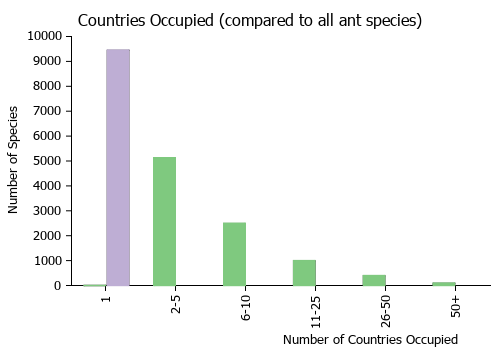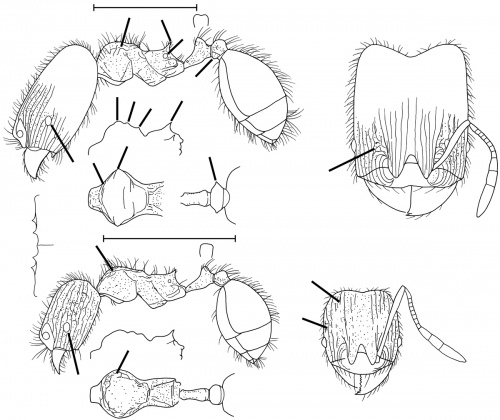Pheidole furtiva
| Pheidole furtiva | |
|---|---|

| |
| Scientific classification | |
| Kingdom: | Animalia |
| Phylum: | Arthropoda |
| Class: | Insecta |
| Order: | Hymenoptera |
| Family: | Formicidae |
| Subfamily: | Myrmicinae |
| Tribe: | Attini |
| Genus: | Pheidole |
| Species: | P. furtiva |
| Binomial name | |
| Pheidole furtiva Wilson, 2003 | |
The type colony was found nesting in soil beneath a pat of dried cow dung in a grassy, grazed meadow with scattered juniper (Stefan Cover). Other colonies were found by Cover beneath a rock in a grassy juniper flat, in a cryptic soil nest on a rocky hillside covered by acacia-opuntia scrub, and under a rock in an overgrazed, grassy creek valley. (Wilson 2003)
Identification
See the description in the nomenclature section.
Keys including this Species
Distribution
Known only from several Arizona collections made by Stefan Cover in the Chiricahua Mts., 1550–1650 m; Pajarito Mts., Santa Cruz Co., 1110 m; and Patagonia Mts., 1420 m. (Wilson 2003)
Latitudinal Distribution Pattern
Latitudinal Range: 31.93202° to 31.351°.
| North Temperate |
North Subtropical |
Tropical | South Subtropical |
South Temperate |
- Source: AntMaps
Distribution based on Regional Taxon Lists
Nearctic Region: United States (type locality).
Distribution based on AntMaps
Distribution based on AntWeb specimens
Check data from AntWeb
Countries Occupied
| Number of countries occupied by this species based on AntWiki Regional Taxon Lists. In general, fewer countries occupied indicates a narrower range, while more countries indicates a more widespread species. |

|
Estimated Abundance
| Relative abundance based on number of AntMaps records per species (this species within the purple bar). Fewer records (to the left) indicates a less abundant/encountered species while more records (to the right) indicates more abundant/encountered species. |

|
Biology
Castes
Worker
Minor
Images from AntWeb
   
| |
| Worker. Specimen code casent0102877. Photographer Jen Fogarty, uploaded by California Academy of Sciences. | Owned by CAS, San Francisco, CA, USA. |
Nomenclature
The following information is derived from Barry Bolton's Online Catalogue of the Ants of the World.
- furtiva. Pheidole furtiva Wilson, 2003: 425, figs. (s.w.) U.S.A.
Unless otherwise noted the text for the remainder of this section is reported from the publication that includes the original description.
Description
Similar in various traits to Pheidole chalca, Pheidole floridana, Pheidole daphne, Pheidole nebulosa, Pheidole quercicola, Pheidole specularis, Pheidole stomachosa and Pheidole tysoni, but easily distinguished as follows.
Major: dark yellow; head elongate, subrectangular; eyes very small; from above, humeri angulate and overhanging rest of pronotum, and in dorsal-oblique view are bilobate; mesonotal convexity in dorsal-oblique view angulate; propodeal spiracles large; propodeal spines robust, directed backward; angular subpostpetiolar process present in side view; postpetiole from above broad and spinose; small patch of rugoreticulum present behind each antennal fossa.
Minor: head mostly carinulate and foveolate, with a rugoreticulum behind each eye; anterior and lateral margins of pronotal dorsum rugulose and rugoreticulate, and all of mesosoma foveolate.
MEASUREMENTS (mm) Holotype major: HW 0.90, HL 1.08, SL 0.56, EL 0.06, PW 0.46. Paratype minor: HW 0.54, HL 0.60, SL 0.52, EL 0.04, PW 0.32.
COLOR Major: body dark yellow, appendages medium yellow.
Minor: concolorous medium yellow.
Figure. Upper: holotype, major. Lower: paratype, minor. Scale bars = 1 mm.
Type Material
ARIZONA: 6.9 km west-northwest of junction FSR42 and FSR42B, Cochise Co., 1650 m, col. Stefan Cover. Museum of Comparative Zoology
Etymology
L furtiva, hidden, concealed, alluding to the nest site.
References
- Wilson, E. O. 2003. Pheidole in the New World: A dominant, hyperdiverse ant genus. Harvard University Press, Cambridge, MA. (page 425, fig. major, minor described)
References based on Global Ant Biodiversity Informatics
- Cover S. P., and R. A. Johnson. 20011. Checklist of Arizona Ants. Downloaded on January 7th at http://www.asu.edu/clas/sirgtools/AZants-2011%20updatev2.pdf
- Johnson R. Personnal Database. Accessed on February 5th 2014 at http://www.asu.edu/clas/sirgtools/resources.htm
- Wilson, E.O. 2003. Pheidole in the New World: A Dominant, Hyperdiverse Genus. Harvard University Press


